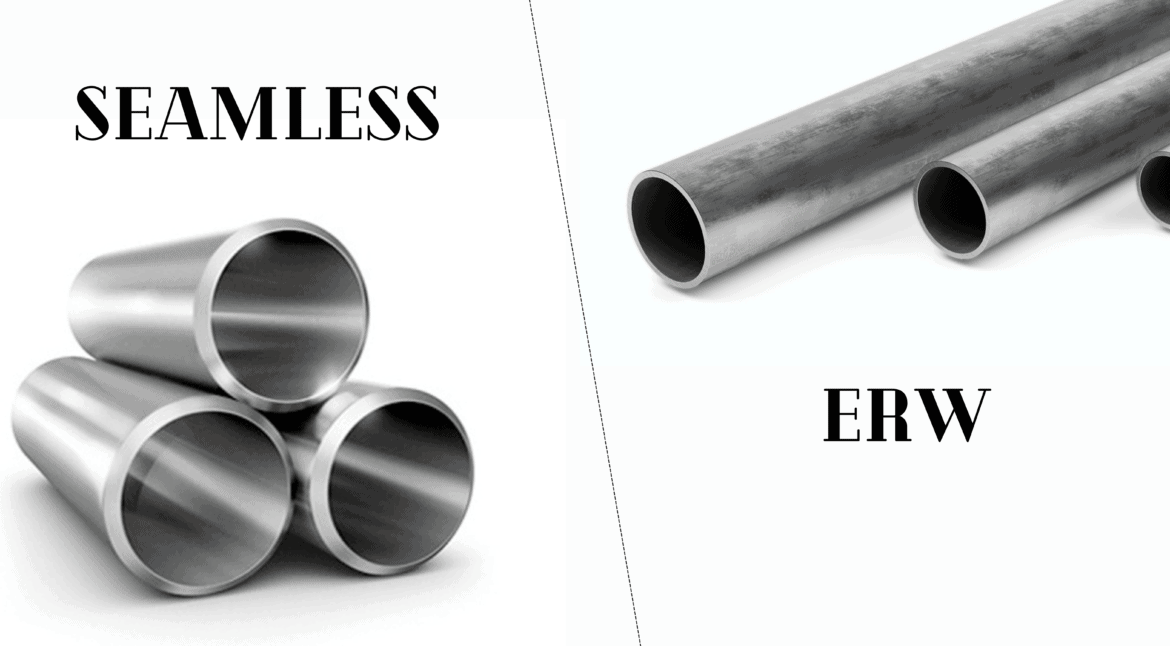Introduction ERW and Seamless Pipe
When it comes to pipes used in various industries, it’s essential to understand the key differences between different types of pipes to ensure optimal performance and reliability. In this article, we will delve into the differences between ERW and seamless pipes. We will explore their construction, applications, advantages, and more to provide you with a comprehensive understanding of these pipe types.
Difference Between ERW and Seamless Pipe
What is erw pipe full form & What is ERW Pipe?
ERW pipe, short for Electric Resistance Welding pipe, is manufactured through a process that involves the application of a combination of heat and pressure. In this method, a flat steel strip is transformed into a round shape and then welded longitudinally using electrical resistance. The weld is typically achieved by passing a high-frequency current through the edges of the strip. To Manufacture ERW Stainless Steel Pipes HR Coils are required. Major Indigenous suppliers of these HR Coils are SAIL, Essar, JSW, Lloyds etc.
What is Seamless Pipe?
Seamless Pipe Meaning
Seamless pipes are known for their strength, reliability, and uniformity. They are commonly used in various industries such as oil and gas, petrochemical, power generation, and automotive, where the transportation of fluids or gases under high pressure or extreme temperatures is required.
On the other hand, seamless pipes are manufactured without any welding or seams. They are produced by piercing a solid billet of steel and then extruding it to form a hollow tube. This process ensures that there are no weak points or potential areas of failure along the length of the pipe. Seamless Steel Pipe is made from a solid round steel ‘billet’ which is heated and pushed or pulled over a form until the steel is shaped into a hollow tube. Billets are procured both from indigenous suppliers and from abroad. The major Indigenous supplier is Mahavir Metals India and steel round billets are imported from renowned mills in Europe, Far East countries, Canada, and China.
How to Identify Seamless vs ERW pipe?
To determine whether a stainless steel pipe is seamless or ERW (Electric Resistance Welded), you can follow these steps. Simply read the stencil or markings on the side of the pipe for identification:
- Look for the ASTM (American Society for Testing and Materials) designation.
- If the stencil reads “ASTM A53,” it indicates the pipe’s specification.
- Check the specific type mentioned on the stencil:
- “Type S” signifies a seamless pipe.
- “Type F” refers to a furnace-welded pipe.
- “Type E” indicates an Electrical Resistance Welded pipe.
This straightforward method allows you to easily identify whether a pipe is seamless or ERW.
It is worth mentioning that the perception that seamless pipes are flaw-free while welded pipes have inherent flaws throughout their length is an outdated myth. Each product form and manufacturing method has its own set of potential problems and defects. It is essential for consumers to familiarize themselves with these issues and understand how they may impact specific applications. By considering factual information rather than relying on myths, purchasers and designers can make informed decisions.
Construction
ERW Pipe Construction
ERW pipes are constructed through the following steps:
- Steel Strip Preparation: The process starts with the preparation of a steel strip, which is carefully inspected for any defects or impurities.
- Forming: The strip is then shaped into a circular shape through a series of rollers or a machine.
- Welding: Once the strip is formed into a circular shape, the edges are welded together using electrical resistance.
- Sizing: The welded pipe is then passed through sizing rolls to achieve the desired dimensions and thickness.
Seamless Pipe Construction
Seamless pipes are constructed through the following steps:
- Billet Preparation: A solid steel billet is heated and inspected for quality control.
- Piercing: The heated billet is pierced by a mandrel mill to create a hollow tube.
- Extrusion: The pierced billet is then elongated and extruded to the desired length and diameter.
- Sizing: The seamless pipe is sized using a rotary sizer or a reducing mill to achieve the final dimensions.
ERW pipe and Seamless Pipes Applications
Both ERW pipe and seamless pipes find applications across various industries, including:
- Oil and gas transportation
- Water transmission
- Structural and mechanical applications
- Plumbing systems
- Heat exchangers
- Boiler tubes
- Automotive industry
Advantages of ERW Pipe
ERW pipes offer several advantages, including:
- Cost-Effective: ERW pipes are generally more cost-effective compared to seamless pipes, making them a popular choice for various applications.
- Availability: ERW pipes are readily available in a wide range of sizes, making them easily accessible for different projects.
- Strength: The welding process used in ERW pipes enhances their strength and durability, making them suitable for demanding applications.
- Versatility: ERW pipes can be easily modified, fabricated, or welded to meet specific requirements.
Advantages of Seamless Pipe
Seamless pipes offer several advantages, including:
- Superior Strength: Seamless pipes do not have any welds, which eliminates the potential weak points. This makes them stronger and more resistant to pressure.
- Enhanced Performance: The absence of seams in seamless pipes ensures smoother flow and reduces the risk of leaks or failures.
- Corrosion Resistance: Seamless pipes, especially those made from alloys, exhibit excellent resistance to corrosion and are suitable for corrosive environments.
- Aesthetic Appeal: Seamless pipes have a smooth and polished surface, making them visually appealing and ideal for architectural applications.
Differences in Strength
The strength of ERW and seamless pipes can vary based on several factors, including the manufacturing process, material used, and quality control measures. However, in general, seamless pipes tend to have higher strength due to their uninterrupted grain structure and absence of welds.
Cost Comparison
In terms of cost, ERW pipes are typically more affordable compared to seamless pipes. The absence of complex manufacturing processes and the availability of raw materials contribute to their lower cost. However, it’s important to consider the specific requirements of your project and consult with experts to determine the most suitable pipe type based on your budget and performance needs.
How Can Mahavir Metals India Helps
Mahavir Metals India is one of the leading Suppliers and exporters of ERW Stainless Steel pipes from India. We export ERW steel pipes in various dimensions and shapes. We are also one of the largest Stainless Steel pipes exporters from India. We use the finest quality raw material to produce SS pipes, which are ISO and OHSAS certified. Our Stainless Steel Suppliers unit is capable of producing large and customized orders from our clients around the world. Visit or Mail us for more information about our ERW stainless Steel pipes. Stainless steel pipe supplier from India. Stainless Steel pipe exporter from India.
FAQs
Q: What are the main differences between ERW and seamless pipes?
ERW pipes are welded longitudinally, while seamless pipes are produced without any welding or seams. This difference affects their construction, strength, and overall performance.
Q: Where are ERW and seamless pipes commonly used?
ERW and seamless pipes find applications in various industries, including oil and gas transportation, water transmission, structural and mechanical applications, plumbing systems, and more.
Q: Are seamless pipes more expensive than ERW pipes?
Yes, seamless pipes are generally more expensive due to the complex manufacturing processes involved. However, it’s important to consider specific project requirements and consult with experts for an accurate cost comparison.
Q: Which type of pipe is stronger?
In general, seamless pipes tend to have higher strength due to their uninterrupted grain structure and absence of welds.
Q: Can ERW and seamless pipes be used interchangeably?
While ERW and seamless pipes have similar applications, their differences in construction and performance make them suitable for specific use cases. It’s important to consult with professionals to determine the most suitable pipe type for your project.
Q: Are seamless pipes more resistant to corrosion?
Seamless pipes, especially those made from alloys, exhibit excellent resistance to corrosion. Their smooth interior surface and absence of welds contribute to enhanced corrosion resistance.
Conclusion
Understanding the difference between ERW and seamless pipes is crucial when selecting the right pipe type for your project. Both pipe types have their advantages and applications, and the choice depends on factors such as budget, performance requirements, and specific project needs. By considering the information provided in this article, you can make an informed decision and ensure the successful implementation of your piping system.


